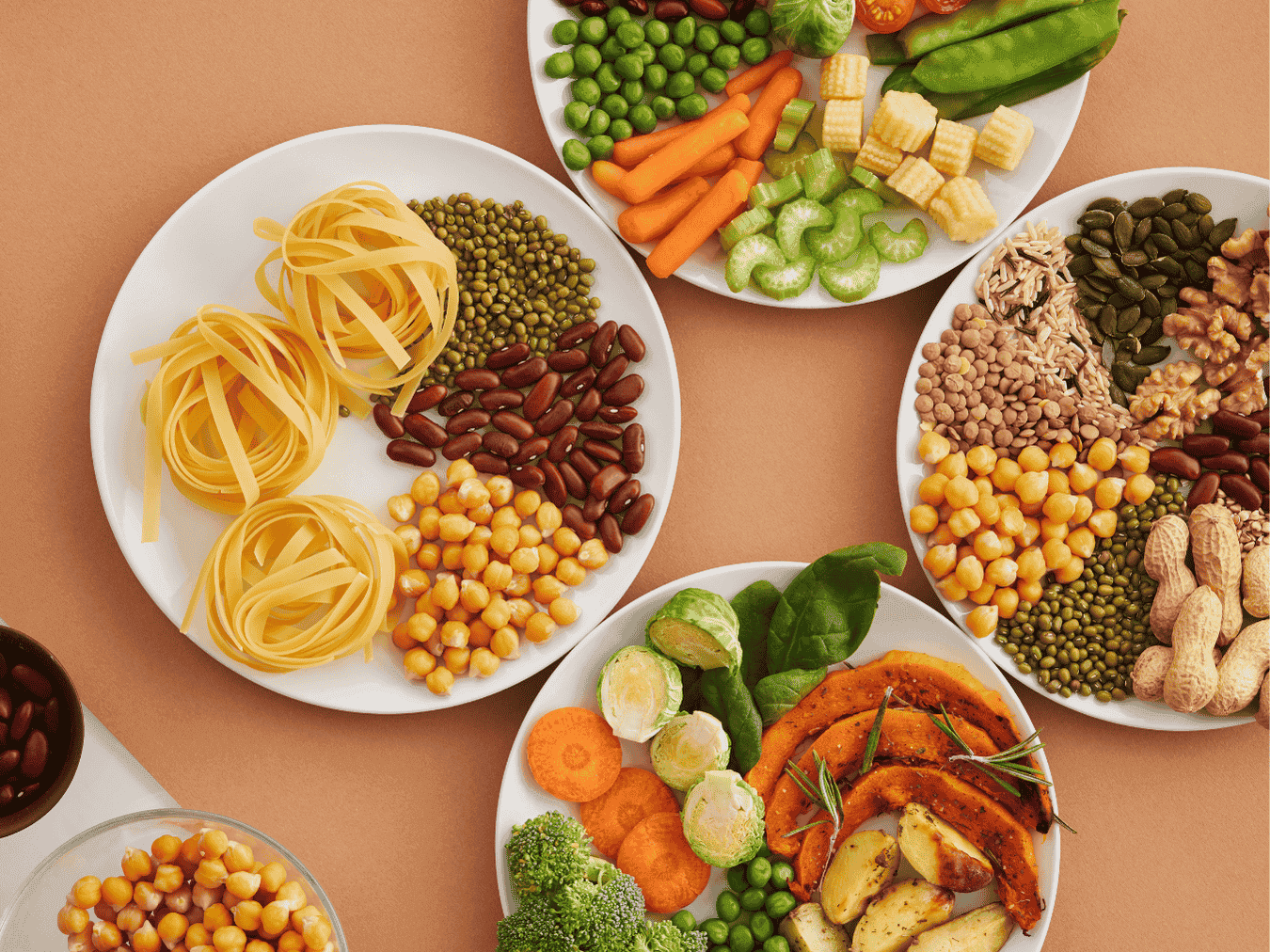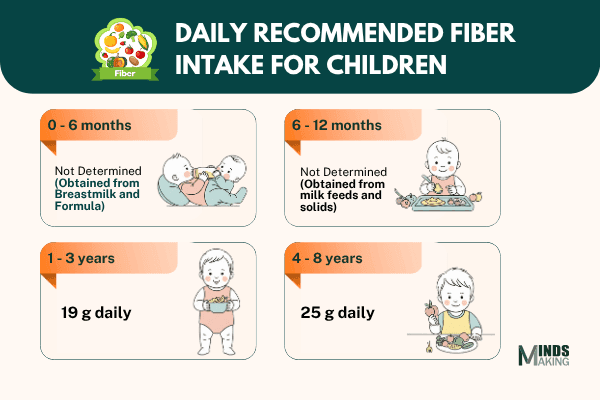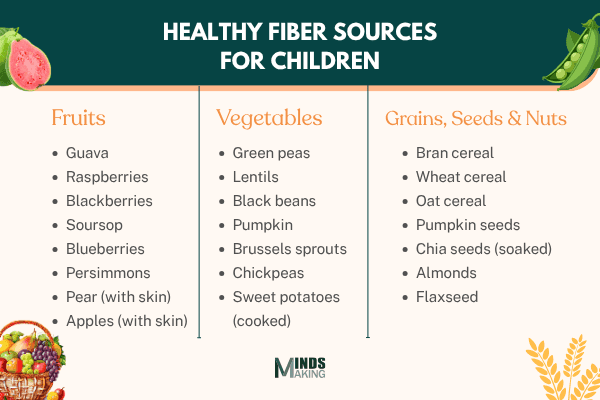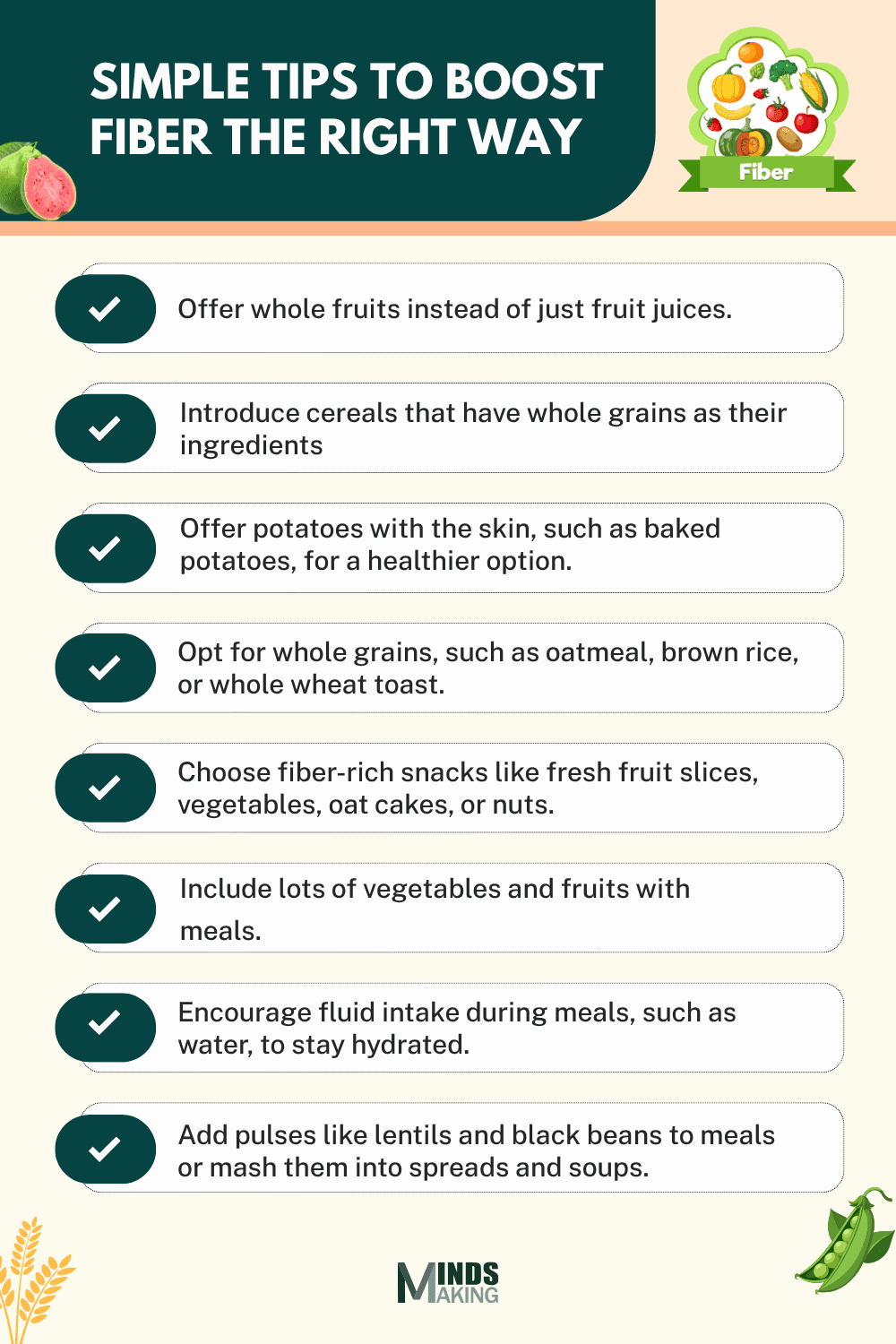Fiber for Babies and Children
Pexels

Written by Mindsmaking Medical Writer
Fact Checked by Mindsmaking Professionals
24th, November, 2025
Fibre plays a key role in supporting digestion and gut health in babies and children, and it may even reduce the risk of chronic illnesses later in life. But is there such a thing as too much fibre? This guide explains what you need to know.
It’s completely normal to worry about whether your little one is getting the right nutrients, especially when they start transitioning to solid foods. You might find yourself questioning how much fibre your baby or toddler needs, particularly if you’ve noticed ongoing issues like slow bowel movements or those uncomfortable, painful poos that make you both wince.
Fiber does more than just keep things moving in the gut; it supports healthy digestion, nurtures the gut microbiota, improves metabolic health, and even aids in preventing chronic diseases later in life, such as colorectal carcinoma and cardiovascular disease [1]. Good fiber intake in childhood lays the foundation for long-term digestive health and metabolic benefits.
As babies begin eating solids, typically around 6 months, fiber becomes an essential part of their growing diet as it is needed to support digestion. However, the daily fibre needs for babies and toddlers vary significantly by age, differing between infants, toddlers, and older children.
This article will guide you through everything you need to know about fiber for babies and toddlers, from their daily requirements, best fiber foods, signs of fiber deficiency, fiber supplements, and how to incorporate fiber into your child's diet.
Key Takeaways
For children aged 2 and older, the recommended daily fiber intake is calculated by adding 5 grams to their age in years. For example, a 2-year-old should get about 7 grams of fiber per day.
Fiber supplements are safe for children only when necessary and recommended by a healthcare provider.
Too much fiber, especially when given without enough fluids, can lead to bloating, gas, abdominal pain, and constipation. Therefore, it is essential to adhere to the daily recommendation.
The best fiber-rich foods for children include fruits such as raspberries and pears, as well as vegetables like peas, yams, lentils, Brussels sprouts, and carrots. Additionally, whole grains like oatmeal, wheat cereal, and chia seeds are also beneficial.
Experts recommend obtaining fiber from a variety of sources—such as fruits, vegetables, whole grains, and legumes—since relying too heavily on one type of food may not provide your child with the balanced nutrition they need.
How Much Fiber Does My Child Need?
The recommended daily fiber intake for children varies with age. For those aged 2 and above, a common guideline is to consume fiber equal to their age plus 5 grams per day [2]. For instance, a 2-year-old would need about 7 grams daily, while a 10-year-old would need around 15 grams.
Research also supports a broader safe range of intake—from age plus 5 to age plus 10 grams per day—depending on individual needs, as long as it remains within this healthy window.
Infants get most of their nutrition from breast milk or formula, which naturally contains very little fiber. Once solid foods are introduced around 6 months, their fiber intake begins to increase. However, there is no officially established daily fiber requirement for babies under 1 year old.
The daily recommended intake of fiber for children includes [4]:
- 0 - 6 months - Not Determined (Obtained from Breastmilk and Formula)
- 6 - 12 months - Not Determined (Obtained from milk feeds and solids)
- 1 - 3 years - 19 g daily
- 4 - 8 years - 25 g daily
It is essential to adhere to the daily recommended intake, as studies indicate that an insufficient fiber intake can lead to signs of constipation in children [3].
Mindsmaking

Are Fiber Supplements Safe for Children?
Fiber supplements are safe for children only when necessary and recommended by a healthcare provider. The American Academy of Pediatrics (AAP) recommends prioritizing dietary fiber for children through whole foods, aiming for about five servings of fruits and vegetables per day, along with other fiber-rich foods, rather than relying on supplements [5].
Fiber supplements are generally reserved for specific medical needs, such as chronic constipation, where dietary changes haven't worked.
Doctors may suggest fiber supplements if a child has been diagnosed with constipation and diet changes do not relieve it, or with specific gastrointestinal conditions such as irritable bowel syndrome (IBS) [7]. In these cases, fiber for your child may need a boost beyond what foods can offer, such as supplements.
Types of Fiber Supplements
Fiber supplements can come in the form of gummies, capsules, or powders, and pediatricians may recommend fiber supplements such as [10]:
- Psyllium (Metamucil)
- Methylcellulose
- Inulin
- Arabinoxylan
- Wheat dextrin
- Calcium polycarbophil
High fiber intake can affect nutrient intake and absorption, as well as the gut microflora, by influencing the bioavailability of nutrients [8]. That’s why supplements should never replace healthy fiber sources, such as whole fruits or baby purees made from fruits and vegetables high in fiber, unless advised to do so by a pediatrician.
Whole foods offer more than just fiber—they help relieve constipation and are packed with essential vitamins, minerals, and phytonutrients that support overall digestive health. Research shows that fiber-rich options, such as whole fruits, especially those high in fruit fiber, help hydrate the gut and protect against constipation, irritable bowel syndrome (IBS), and inflammatory bowel disease (IBD), promoting a healthier, more balanced digestive system over time [6].
Can Too Much Fiber Harm My Child?
Excessive intake of fiber for children, especially when consumed too quickly, can cause problems such as bloating, gas, and even cramping. High-fiber foods tend to be more filling than other foods and can leave one feeling full for a longer period. [7]. So it is best to offer it in moderation so the child won't feel too full to eat other meals.
Signs of High Intake of Fiber in Children
When high-fiber foods are introduced too frequently and in excess of the daily recommendation, children may begin to exhibit signs of excessive fiber intake. Signs such as [10]:
- Frequent bloating
- Tummy pain
- Gassiness or flatulence
- Loose stools or diarrhea [17]
- Slow weight gain [16]
How to Make Sure Your Child Isn’t Eating Too Much Fibre
To maintain your child's digestive health and prevent overloading their gut, it's essential to strike a balance in their fiber intake that is neither too high nor too low. Here are some tips to help:
- Introduce fiber to babies gradually, only after they are 6 months old.
- Balance fruits rich in fiber and vegetables high in fiber for babies with energy-dense foods like avocado or steamed carrots and mashed potatoes.
- Offer enough fluids, such as water. It is key to helping fiber move through the digestive system effectively.
- Stick to age-appropriate portions of healthy fiber sources, not adult-sized servings.
- You can mix different fiber-rich foods in one serving rather than relying on just one type in huge portions.
Read This Next
No posts available
What Are Good Sources of Fiber for Children?
The best fiber-rich foods for children come from whole foods, such as fruits, vegetables, grains, legumes, and seeds. These healthy fiber sources provide both soluble and insoluble fibers, which are beneficial for supporting digestion, regulating bowel movements, and promoting a healthy gut microbiome [13].
Consuming fluids with meals is important, as fiber and fluids work together to support digestion. Offering children lots of fiber without enough water can backfire, causing constipation instead of relieving it. Adequate hydration helps fiber expand and move waste through the intestines more efficiently. Therefore, always pair fiber-rich foods with water, breast milk, or formula for optimal digestive health.
Healthy Fiber Sources for Children
Fruits contain high amounts of dietary fiber that can improve gut health, boost immune function, and also provide essential vitamins. Fruits such as [12]:
- Guava
- Raspberries
- Blackberries
- Soursop
- Blueberries
- Persimmons
- Pear (with skin)
- Kiwifruit
- Apples (with skin)
Leafy vegetables and root vegetables contain dietary fiber that is important to the bodies of growing children. Veggies such as:
- Green peas
- Lentils
- Black beans
- Pumpkin
- Brussels sprouts
- Chickpeas
- Sweet potatoes (cooked)
- Broccoli
- Avocado
- Cauliflower
- Carrots (cooked)
Some whole grains, seeds, and nuts are great sources of dietary fiber for kids. Foods such as:
- Bran cereal
- Wheat cereal
- Oat cereal
- Pumpkin seeds
- Chia seeds (soaked)
- Almonds
- Flaxseed
Mindsmaking

How Can I Add More Fiber to My Child's Diet?
You can increase fiber intake for babies and toddlers by offering a variety of whole foods daily, especially whole fruits, vegetables, legumes, and whole grains. Experts recommend obtaining fiber from a variety of sources, as consuming excessive amounts of a single type of food may not provide your child with a healthy, balanced diet [11].
Simple Tips to Boost Fiber the Right Way
Here are some simple tips on how to boost your child's fiber intake with a variety of meals [11] [13]:
- Offer whole fruits instead of just fruit juices.
- Introduce cereals that have whole grains as their ingredients.
- Offer potatoes with the skin, such as baked potatoes, for a healthier option.
- Opt for whole grains, such as oatmeal, brown rice, or whole wheat toast.
- Choose fiber-rich snacks like fresh fruit slices, vegetables, oat cakes, or nuts.
- Include lots of vegetables and fruits with meals.
- Encourage fluid intake during meals, such as water, to stay hydrated.
- Add pulses like lentils and black beans to meals or mash them into spreads and soups.
Mindsmkaing

Frequently Asked Questions
Can babies eat high-fiber foods?
Babies can start eating high-fiber foods once they begin solids, typically around 6 months. You can focus on naturally soft or pureed fruits rich in fiber, such as pears or kiwifruit, and gentle vegetables high in fiber, like peas or carrots, for babies.
How can I tell if my toddler is getting enough fiber?
You will know your toddler is getting enough fiber when they have regular bowel movements and less straining when taking a poop because adequate intake of fiber helps in healthy digestion.
What drinks help with fiber digestion?
Fluids like water help to support the digestion of fiber in kids. It helps move fiber through the digestive tract smoothly, preventing constipation.
Can fiber help with diarrhea in kids?
Offering soluble fibers, such as those found in oats, bananas, and pears, can help manage diarrhea in children by absorbing excess fluid in the intestines. However, insoluble fibers, such as those found in leafy greens, may exacerbate diarrhea, so it’s best to consult a doctor for guidance on how to proceed.
What’s the difference between soluble and insoluble fiber for kids?
Soluble fiber dissolves in water to form a gel-like substance that helps slow digestion, manage blood sugar levels, and prevent diarrhea. Insoluble fiber, on the other hand, does not break down and adds bulk to the stool, supporting regular bowel movements.
Can picky eaters still get enough fiber?
Picky eaters can still meet their fiber needs with a bit of creativity. Incorporating fiber-rich snacks, such as oat muffins, fruit smoothies, or veggie-based sauces, into toddler meals can help boost intake. Using dips, fun shapes, or hidden veggies often helps increase acceptance.
Is fruit juice a good source of fiber?
Most fruit juices lack fiber because it’s strained from the pulp. Whole fruits are much better sources of healthy fiber than juices. If juice is offered, limit it to 4 ounces per day for toddlers over 12 months old, and choose options with pulp when possible
How do I prepare fiber-rich foods safely for babies and toddlers?
To safely serve fiber to babies and toddlers, offer soft or cooked foods in age-appropriate portions to prevent choking. Hard, round, and sticky foods can cause choking in babies and should be replaced with safer options, such as soft-cooked lentils, pureed beans, and finely grated vegetables.
Are fiber bars or packaged snacks okay for kids?
While some fiber bars are acceptable, many are ultra-processed and contain added sugars or inulin, which can cause gas or bloating in young children. Whole foods or fiber-rich snacks, such as fruit slices, whole-grain toast, or soft veggie patties, are typically better for toddlers.
Can fiber help my child feel fuller longer?
Fiber can be heavy and slow to digest, which contributes to the feeling of fullness after meals. High-fiber meals made with the best grains or vegetables can keep kids full between meals, reducing mindless snacking and helping in weight management.
Does a lack of fiber always cause constipation?
Low fiber intake is a common cause of constipation; constipation can also be caused by dehydration, low physical activity, changes in routine, or emotional stress. Ensuring adequate fluid intake, engaging in regular physical activity, and maintaining a consistent toileting routine can help alleviate constipation.
Was this article helpful?
How many stars are you giving this article?
Leave a comment
Your email address will not be published.